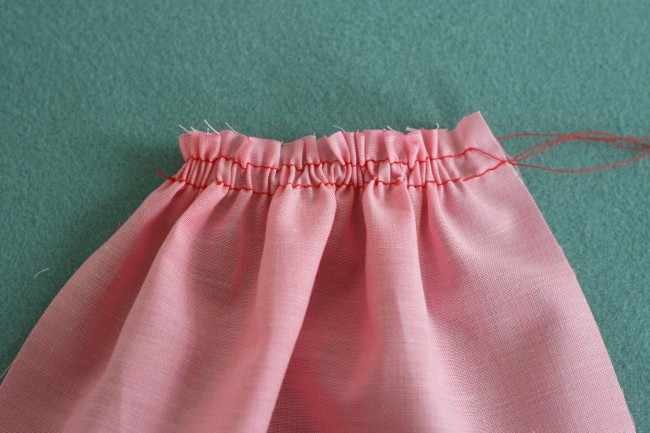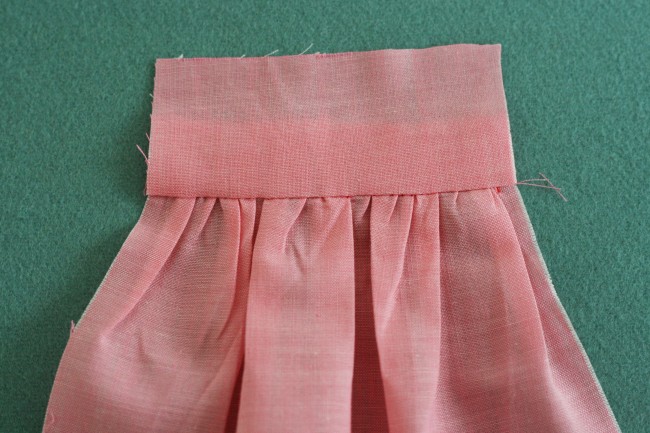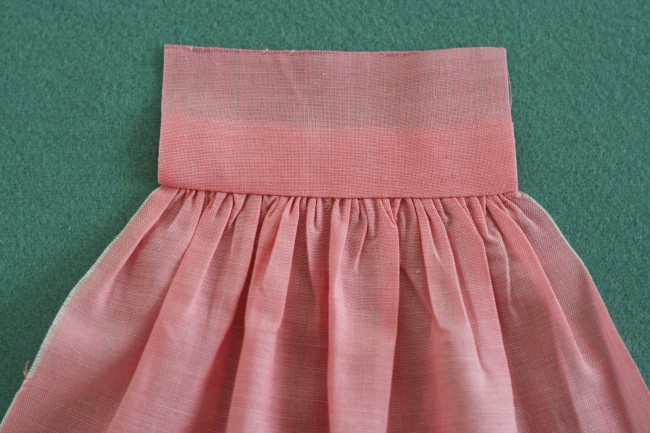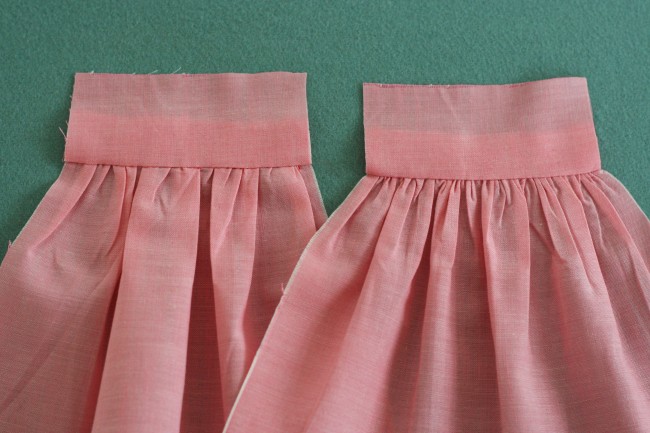Colette Sewing Handbook: Gathering Stitches
We’re going to be highlighting a few tips and tricks from the Colette Sewing Handbook this month! To kick it off, let’s start with gathering stitches. Take a look below to see the difference between two and three row basting.
Gathering is usually done with a basting stitch sewn on your machine. It can be done by hand but will take a good deal longer to do. To begin a basting row always back stitch after the first stitch. Backstitching at the beginning allows you to pull the thread at one end while it remains tacked at the other. Remember to pull from the bobbin thread which is less likely to break.
When there are more rows, the gathers have a chance to be more even and controlled. With the three rows of basting the stitching line went between the second and third stitches. This shouldn’t be done on delicate fabrics or loose weave fabrics because the holes from the basting may be permanent. When sewing gathers, be sure that they are face up and at a right angle to the sewing foot, not angling off toward you. This will keep the gathers straight.
Two Rows of Basting
Two rows of basting offers less control of the gathers. Note how large the ruffles are.
Three Rows of Basting
The three rows of basting has more control and smaller gathers.
Two Rows with a Band
Once sewn to a band, the fabric with two rows of basting have wide gathers and are relatively uneven.
Three Rows with a Band
With three rows the gathers are closer together and more evenly spaced.
What do you think? Would you use three rows over two? What tricks do you use when creating gathers on a garment?
Some related posts you may be interested in:
- The Colette Sewing Handbook Announcement: read more about what’s in the book!
- How the book was hatched: Sarai tells us the story of her book’s beginnings
- Behind the Scenes: watch a fun video of the book photo shoot!

 Sign In
Sign In







Comments
Ms.Cleaver
November 9, 2011 #
Ooo- thanks for this tip. I often have a problem with uneven gathers – I’ll have to try this next time!!
Lieke
November 9, 2011 #
Wow, what a good trick! I always had this problem, can’t wait to try this!
Abfabulies
November 9, 2011 #
Wow. I’ve always done this with two rows and a lot of frustrations while trying to get it all evened out. Never thought about using three rows. Thanks for the tip!
Annie
November 9, 2011 #
One thing I learned about gathering is to do the basting stitches in a different colour thread – preferably a very bright, obvious colour. That way when you go to pull them out, there is absolutely no confusion about which threads to remove.
Caitlin
November 9, 2011 #
Thanks for sharing, Annie, that’s a great tip!
Jennifer
November 9, 2011 #
thanks so much for this! I hate gathers even more than I hate zippers! Will definitely try the three rows next time, although its not the gathering so much as the stitching over of the gathers that gets me into so much trouble :S
Elizabeth
November 9, 2011 #
This is one trick I actually knew but am usually too lazy to use! The contrast of seeing the results side by side might convince me otherwise, though, next time I need to gather fabric. Inexplicably, it never really occurred to me to do a backstitch at the start of the gathers; I’ve always left the threads long and then pulled from either side, which is definitely more difficult than doing it if there’s a bit of an anchor in there, so thanks for that!
Abby
November 9, 2011 #
Wow, I am such a beginner! When I’ve needed to gather, I’ve only used one row! I’ll definitely be using this tip.
Doortje
November 9, 2011 #
I think, this is one of the things that you’ve meant in the interview: ‘My concept was to build on the sewing fundamentals that are so often overlooked’.
This is probably one of them. I’ve never done it this way, as I learned sewing from my grandma and she used to stitch only two rows of basting. 3 definitely looks better! My granddaughter (one day in the far future) is definitely going to learn to stitch 3 rows!
Sally
November 9, 2011 #
Wow, I had no idea!
Super Bloomers
November 9, 2011 #
I never even thought of using three rows! It looks much nicer. When I made my latest gathered skirt I had such troubles with all the gathering. Thank you for the post!
Melissa
November 9, 2011 #
I just received my copy of the handbook, yesterday, and I learned so many things I didn’t know in just the FIRST section (and I’ve been sewing for years)! This gathering trick was one of those things. I absolutely LOVE your book! Makes me wish I hadn’t of wasted time making all of my clothes the wrong way over the years – ha!
Claire (aka Seemane)
November 9, 2011 #
I never realised the difference an extra row of basting could make – I prefer it with the 3 rows :)
I currently use the Zig-zag over a cord technique for my gathering, see these links below :) :-
(1) easy gathering technique (Tip/Technique)
(2) Gathering Seam…How to gather a seam
(3) How to Easily Gather Fabric: A Sewing Tutorial
Naomi
November 9, 2011 #
Oh, gosh! I sure wish I had of thought of doing three rows of gather stitches instead of two when I finished off my daughter’s dress on Monday. While I think it turned out ok, looking at these examples – I feel it would have benefited greatly from three rows. Oh well! Next time!
Catholic Bibliophagist
November 9, 2011 #
One thing which puzzles me is that pattern directions so often tell you to put the second line of gathering stitches at the seam line. And then you’re supposed to gather right on the second line of gathering stitches.
I put one line of gathering stitches above the seam line and the other one below it. Then I stitch the seam between them. The gathers look much nicer and you only really have to pull out the bottom row of gathering stitches. I get a similar result to your using three rows, but I’m going to take your suggestion to see if it will look even better.
Thank you for this tip.
–C.B.
Aylwen
January 27, 2012 #
Yes, I use the two row method, one row close to the selvage, the other one about 2cm in. Once gathered I sew the seam 1.5cm from the selvage.
Rachel
November 9, 2011 #
I’ve honestly avoided gathers because I can never get them to look right. So I’m going to have to give this a try for sure!
Samina
November 9, 2011 #
Wow – I would have never realized that one more row could make such a difference! Thanks for the visual. It really shows the difference.
Libby
November 9, 2011 #
I am slowing getting back into sewing since I know have two beautiful granddaughters and there are so many cute patterns out there for them. I have sewn all through high school and quit after my daughter was born (I used the excuse I didn’t have time) which I fully reqret now. Things are coming back to me and I use every extra minute I have to sew. I have my own sewing room so I can just walk away when I hear “Granny, what ‘cha doing”….. but that’s after I have some help getting to a stopping point….just lovin’ it. So if I can find a short cut, reminder or a quick lesson, hey I’m all for it. Sewing is my Stress Releif after a hard day at work………
simone
November 9, 2011 #
Loved to watch ‘behind the scenes’ and see the dresses actually worn and moving. You must have had so much fun!!!
Sigrid
November 9, 2011 #
I agree that three rows looks better, but if you look between the gathering rows, it is about the same. That’s where the most control is and where I usually try and make my final seam. Give it a try!
Rebecca
November 9, 2011 #
This will come in handy! Thanks!
jeanine
November 9, 2011 #
This is so timely. I’m going to finish my dress tonite and have to do the skirt…I’m going to try this out! The proof is in those pics, definitely!
Roisin
November 9, 2011 #
This is an excellent tip, and one I will undoubtedly use! Gathering wrecks my head – although I love how it looks. I’d seriously rather sew darts all day than gather, but this might just change my mind :)
Mary
November 9, 2011 #
Wow! This post is making me want the book right away! Would the 3 row approach work just as well with knits?
ms. modiste
November 9, 2011 #
Wow, thank you so much for this post! I’ve always disliked how imprecise gathering is and I think you’ve illuminated the trouble I was having with the 2 lines of basting! I’m motivated to try another gathered project now in order to give 3 lines a go!
Awfulknitter
November 9, 2011 #
Why the heck have I never come across this technique before?! I can maybe understand not putting it in patterns (their directions aren’t always so great), but I have two sewing books that I happen to think are pretty good, and both have the two rows of basting technique…
Perpetual Beginner
November 9, 2011 #
It’s been a long time since I’ve done gathers, but I was definitely taught to use two rows. It makes such a big difference for such a little change.
My handbook arrived today, and I’ve been poking through it ever since. I love the Truffle dress!
Jacqui
November 9, 2011 #
Wow, and I thought I was being sophisticated using two lines instead of one! I usually do one row on either side of the seamline, where do you place the three lines in relation to it with this method?
Jacqui
November 9, 2011 #
Oh! I read the post a bit more closely and I see you say the seamline goes between the bottom two rows? I’ll definitely try this next time I’m gathering!
Melissa
November 9, 2011 #
Wow! I think this just changed my life. It never occurred to me to do three rows, but I will definitely do this from now on! Thanks for the great tip.
Erica
November 9, 2011 #
Can you show a picture of the gathered fabric sewn to the waistband from the other side? I’m a self-taught sewer and I find that when sewing my gathers I’m never sure what to do – do I let the machine run on and flatten down the gathers or do I try to smooth them out as I go? I’ve tried both with imperfect results. Whatever you’ve done, the 3 rows look lovely.
Marike
November 10, 2011 #
I usually use this trick: http://www.getcreativeshow.com/seminars/fine_gathering.htm
Sarai
November 10, 2011 #
Thanks Marike, this looks great and I especially like the part about adjusting with an awl or needle.
Joolz
November 10, 2011 #
I found the same tutorial that Marike mentions above and it is one of the best sewing tips I have found online. Every other single sewing book/tutorial I have come across always recommends using a longer than normal stitch, except for that one tutorial. I now use a 1mm to 1.5mm stitch, with my tension set to almost zero and have found that gathers are now just so easy to do. The long stitch/loose tension combo needs to disappear and the short stitch/loose tension should be mentioned everywhere possible.
No need for three rows and no need to backstitch at the beginning of each row. Simply sew one row, pivot 90 degrees and sew a couple of stitches, then pivot again and sew the parallel row of stitches. No muss, no fuss.
I suppose for machines that don’t have alterable stitch length, such as my first machine, the third row of stitches is probably a good idea, but if you can alter the stitch length, then the short stitch works so much better.
Jeanine
November 10, 2011 #
Okay, so I did my skirt (of a dress) last night and tried this—it worked out great! I made the mistake of forgetting to backstitch and ended up pulling out all the thread to start over, but the end result was a really nice tight gather. Pulling out the 3rd line of basting that was left exposed was a bit of a pain, but hey, I’m impatient and am pleased with the final result.
Love the book—thanks so much for all your hard work and generous sharing on your blog!
Sarah
November 10, 2011 #
I’ve always done three rows of stitching, but haven’t tacked it at one end. I leave a long tale at the end and then wrap it around a pin in an eight shape to keep it there. I also gather from both ends of the fabric and have found that it leads to a lot less broken basting lines. Then again I’m also gathering textured fabric and lots of it for costumes.
Sarai
November 10, 2011 #
Actually, I often leave long tails at both ends myself, unless I’m just gathering a small section. So I think the backstitching is optional.
Anne
November 10, 2011 #
I wish I knew this a few weeks ago when I was making my first gathered skirt! I still love the skirt but I really wish the gathers were more even. You never fail to come up with little tips and tricks that seem so simple, but make a world of difference in our sewing- I can’t wait to get your book!
Lauren
November 10, 2011 #
I use the zig zag over a cord method, like what Claire suggested. I zig zag with regular thread over the top of top-stitching thread. It works really well in terms of getting the gathers even. Sometimes though, when attaching the gather, the fabric folds over and I have to unpick and re-do that part. Next time, I’m going to try sewing between the zig zag and another line of long stitches to see if I can get that attachment perfect first time! This may be the ultimate gathering technique (for me) of all time!
Christianne
November 10, 2011 #
I also sew over a cord. Its alot faster and you don’t have to pick pick pick at each little stitch. Its easier to take it out too, and you have more control over the gathers.
Also, if you hold the fabric behind the needle as its coming out, the machine will gather it somewhat, which is good for fitting sleeves and such, it comes out perfectly.
luvinthemommyhood
November 11, 2011 #
Wow! This is awesome and just one of the many exciting reasons why I cannot WAIT to have a copy of your fab book! Soooooo only going to use 3 row ruffles from now on. I cannot get over the difference! Thx for the tip!
Victoria
November 12, 2011 #
Wow. I actually took and am now certified in Dressmaking and Design. But they never taught me to gather with the three rows, just long threads at both ends. I took this course so that I could design aprons (proceeds to abused women’s shelters). I wanted ruffles on some of the aprons, but hated the process. I can now make mini ruffles for my matching mini aprons (yes, mini, as they go on your soap bottle in the kitchen to match the cook’s apron. I am headed for the sewing room now.
Thanks so much for this tutorial.
Michelle
November 15, 2011 #
I was taught the method of a zig-zag stitch over a length of buttonhole thread. And I always hated it, so learning the two rows of basting was itself a revelation, three rows even more so. My one trick, when gathering longer lengths (such as a dirndl skirt) is to break up my rows into fourths, so baste 1/4 of the length, leave a tail, repeat around. I’ve found I can keep my fabric gathered more evenly around the whole garment and it feels less like fabric wrangling (fewer gathered clumps).
Jennifer
November 23, 2011 #
Great tips, especially back tacking the first stitch. I have ALWAYS been vexed about gathers dropping off the other end. :-)
Shelly
November 29, 2011 #
Holy Moly! I tried this and it worked like a charm! I’ve been sewing for 30 years and can’t believe I didn’t figure this out on my own. Thanks for a great tip.
Carley
January 27, 2012 #
This is how I learned to gather in high school; dare I admit, back in the late 60’s! I teach the two row method, just because I thought maybe it was passé to have my students do the three rows. I’m definitely going back to old school! Sometimes tried and true is better. Thanks!!!
Carley
January 27, 2012 #
I just read Jennifer’s comment about back stitching at the start because she doesn’t like the gathers dropping off the other end. I still prefer NOT to back stitch as I prefer to pull up the gathers from each end (less chance of thread breaking when it’s a long stretch of gathers). The way to prevent dropped gathers is to place a pin at each end of the stitches, perpendicular to the line of stitches and then wrap the thread tails around the pin in a figure 8. I even sew OVER those pins with the figure 8 thread tails still wrapped around them, and I don’t usually sew over pins!!!
Cathy
April 1, 2012 #
As I sit here reading the tutorial for gathers, I am finishing up a three tiered gather little girls skirt:) I have always used two rows, and can see where three rows of basting stitches would be most beneficial on most fabrics.
Interesting tidbit. When I took sewing in high school, I was shown to make gathering rows with one row of stitching :( Not a fun way to do gathers. I quickly changed that practice to two rows. Great tips for sewing! Thanks for the time you put into all these tutorials. Cathy
Linda Stokes
April 3, 2012 #
I’ve used most methods mentioned by everyone, but do use the 3 rows most often, but….when I have time and I’m making something extra special I use my Amanda Jane pleater to pleat about 5 rows. Makes very even and almost perfect gathers. Just mentioning this method in case some of y’all have a pleater or access to one.
Gertie
January 14, 2013 #
Thank you so much for this tip! I am going to try to remember this for my next project – I don’t think I can use 3 rows on my current project because I am sewing with double gauze which is a bit too loose.
Alyssa
February 27, 2013 #
This is so funny, because I always use to gathered with only one row of basting, and when I switched to two rows it changed my world! I personally think that three rows of basting is over kill, and maybe a waste of time. If you gently tug at the fabric above and below both rows of basting it creates perfect little gathers, and if you sew your final row of stitching in between the two basting stitches, you will have perfect gathers with only two rows of basting.
The size of gathers has nothing to do with how many rows of basting you use, but depends only on how much fabric you’re gathering up! The more fabric you are gathering into any given space the tighter they will be; less fabric will equal less gathers.
Sarai
February 27, 2013 #
Alyssa, I think you can see the difference in the two examples at the end of the post, though. They are both the same size, same amount of fabric.
How it works is that three rows produces more stitches per inch, which results in smaller gathers. You could get the same effect by using a short stitch length, but that might make it harder to pull up the gathers, especially over a long piece of fabric.
Sandi
February 28, 2013 #
I’ve also found that using a shorter stitch length helps give more control with gathers. I used to use 6mm but have now changed to 4 or 4.5 mm. It makes a big difference!
Sandi
February 28, 2013 #
I meant to add that I decrease the needle thread tension with the shorter stitch length, which helps pull up the bobbin thread without breaking it.
Tsu Dho Nimh
July 26, 2013 #
I do 2-row basting, but I mark and pin the fabric evenly along the band before gathering it so it will be evenly spread. And I take the time to make sure the lower row is as tightly gathered as the upper row.
If you look at your 2-row example, it was badly gathered before the seam went in.
RobyGiup
February 18, 2014 #
Thanks for sharing these tips, they are really useful! I never tried the three rows of basting, but for sure next time I’ll use this technique, so much neater!
Christina
March 24, 2014 #
Wow, light bulb moment. I am using the three rows of gathering stitches on a dress this week. This could have been more timely. Thanks for sharing